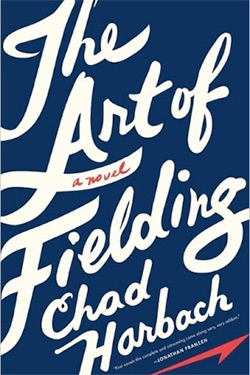The Art of Fielding
by Chad Harbach
reviewed by Mark Chiusano
Baseball and books have often been tied together: Don DeLillo on the Dodgers, Marianne Moore on Yogi Berra, Michael Chabon’s failed novel about the perfect baseball field, John Cheever (“All literary men are Red Sox fans—to be a Yankee fan in literate society is to endanger your life”), and John Updike’s essay on Ted Williams. Updike wrote the piece about a day when he had scheduled an adulterous date with a woman in Boston. She stood him up and he went to the game instead.
Chad Harbach’s debut novel, The Art of Fielding, adds another classic American element—college—to the mix with its story of a small-time university baseball team, and the rise and fall of its star shortstop Henry Skrimshander. Like most good baseball literature, it’s not all about the game. The baseball tropes have been updated and altered—Henry’s teammate, Owen, is gay and reads books on the bench; the catcher, Schwartz, quotes Aurelius—and the story, though centered on the shortstop and his friends, widens to capture a university president, illicit love affairs, literary criticism, a lost Melville manuscript, and the pains of finding one’s place in society.
But life, in Harbach’s novel, is studded with baseball. The baseball moments in the book are often new-leather-glove perfect: a throw described as so straight and quick you could “dry laundry on it”; the way fouling a fastball off the neck of a bat feels in cold weather. But more than this, Harbach presents us with a world according to baseball, a place where a sandy beach, dragged by Parks Department tractors, has the sweeping parallel marks of an infield. Or how we’re shown where Westish College is located: “that little school in the crook of the baseball glove that is Wisconsin.” Even the literary allusions are baseball-related: April is “the cruelest month” for the sport, especially up north.
More than just adhering to theme, these moments demonstrate a philosophy—putting a value on neatness, perfection, and craft. Everything emanates from the focused lens of baseball. The novel claims Melville as its guiding voice—the fictional college’s claim to fame is the wandering writer’s obscure (and also fictional) lecture trip to the campus—resulting in a statue, a baseball team called the Harpooners, and a president whose favorite chapter of Moby Dick is “The Lee Shore”—but the novel doesn’t approach the messiness of Moby Dick or that book’s apocalyptic and biblical proportions. The Art of Fielding would never do what “The Lee Shore” does, for example, dwelling rhapsodically on a character who is more or less unmentioned in the rest of the book. The author Harbach might owe more to is Dickens—in wryness and neatness of plot, and the mixture of flat and round characters—or, more recently, that modern-day writer of the long novel, Jonathan Franzen.
In his essay in n+1, “MFA vs. NYC,” Harbach, who is also a co-founder of the magazine, writes about the dichotomy between the worlds of MFA and NYC fiction: the obscure but safe world of the university and the market-driven one of the New York City publishing industry. The latter has trended towards readability in recent years, as exemplified by Franzen’s novels The Corrections and Freedom. This readability, posits Harbach, is perhaps “the result of a fierce market pressure toward the middlebrow, combined with a deep authorial desire to communicate to the uninterested.” The Art of Fielding similarly wants to be read, to be accessible, and it succeeds. It allows Harbach to sneak in artistically packed moments like the dream sequence toward the end of the novel (quality writing that is perhaps the dream achievement of the MFA writer): “Still he loved the pumpkins, he could lift the big ones, and the field all around was autumn brown.” And it allows room for the disturbing, tragic, only questionably redeemed fall of Henry Skrimshander, star shortstop, and the parallel trajectory of the university president’s daughter, Pella, who is struggling to find happiness in a regular, everyday world, in perhaps a similar vein as Patty, the main character in Franzen’s Freedom.
This is the line The Art of Fielding straddles, perched between complication and simplicity. Baseball, in some ways, is very simple: quick hands, a quiet swing. Sometimes you win, sometimes you lose, sometimes it rains, as they say in Bull Durham. Like the Updike essay and the story behind it: neat like baseball, messy like real life.
Published on March 18, 2013

